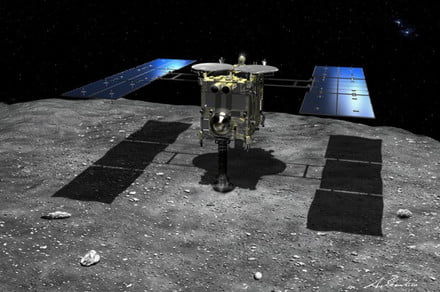An artist’s conception of JAXA Hayabusa 2’s Ryugu landing. JAXA
Japan’s Hayabusa 2 spacecraft has been exploring the asteroid Ryugu since it arrived there at the start of the year. The dramatic science experiments performed so far include shooting a bullet at the asteroid to throw up matter to be collected, which left an impressive crater. But the latest mission has not been so successful.
The aim of this month’s mission was to drop a reflective marker on the asteroid’s surface which would help the craft achieve a second touchdown. The second touchdown mission is being considered as a way to collect more materials, as a bonus to those materials already collected from the first go-round.
The problem is that dropping the marker has proven difficult. The craft began its descent as scheduled on May 15, moving at a speed of 40 centimeters per second. Scientists back home at the Japanese Aerospace Exploration Agency (JAXA) were able to monitor the craft with a relatively short delay time of under 16 minutes, and the craft’s Optical Navigational Camera captured a series of images of the approaching asteroid.
Some 12 hours later, the craft was slowing down as planned and reached an altitude of 4500m. And 11 hours after that, the altitude of the craft was just 300m, and the shadow of Hayabusa 2 was visible on the image of Ryugu.
Then the troubles began, with an automated system aboard the craft halting the descent. “The spacecraft descent has been autonomously aborted at an altitude of about 50m,” JAXA announced in a tweet. “Hayabusa2 is currently rising to the home position. Telemetry from the spacecraft has been confirmed and the spacecraft is normal, but the target marker has not been dropped.”
The scientists are still working on understanding what caused the abort, but in the meantime, the craft had to be moved back into its starting position. Fortunately, this process went well. JAXA announced that on May 17 at 11 a.m. JST, “the spacecraft has returned to the home position.” They signed off with a message of thanks for the support they received from the public during the operating.
The issue now is that Ryugu is heating up fast. Within a few weeks, the asteroid will reach its closest orbital position to the Sun, causing high temperatures on its surface. The heat will make a second touchdown impossible.
Whether the team will be able to make a second touchdown attempt remains to be seen.
Editors’ Recommendations
- See the crater blasted into an asteroid by a Japanese spacecraft
- Unexpected particle plumes discovered jetting out of asteroid Bennu
- Asteroid Ryugu is porous, shaped like a spinning top, and is formed of rubble
- No, it’s not a Michael Bay movie, but a spacecraft just bombed an asteroid
- A tiny pebble could have caused the dramatic self-destruction of a 5-mile-long asteroid

